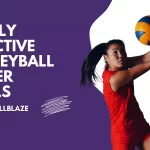Volleyball requires high levels of skill, as well as speed, power, and agility in addition to high levels of skill! What is, however, the most important of these?
This article discusses the fitness requirements for volleyball, which can help with developing training programs for this sport, interpreting fitness test results, and determining a player’s relative strengths and weaknesses.
Fitness Components for Volleyball

Speed
Players must be quick when returning or passing the ball after volleyball serves and smashes result in extremely fast ball speeds. The ability to move quickly as well as react quickly can be developed through sports-specific exercises such as multidirectional sprinting and the use of an uneven ball known as a reaction ball, which bounces unpredictable.
Agility
In order to be agile, you must be able to move your body quickly and efficiently into any position you want. To play a shot in volleyball, you must be in the right place at the right time.
To make successful plays, players often have to dodge, duck, and dive, and the more agile they are, the better they can do this. In order to train for agility, athletes perform activities that mimic the requirements of the sport, such as jumping drills, shooting from awkward positions, running in multiple directions, jumping, and sprinting.
Power
It is very important in volleyball to be able to generate power at high speeds. Because volleyball nets are 10 feet high, players must possess leg strength in order to block and smash balls during play. Upper body power is required to hit the ball with plenty of heat.
In addition to performing variations of the Olympic lifts, plyometrics or jumping exercises, and using medicine balls, power can be developed.
Flexibility
A volleyball return requires limber limbs, or flexibility, to squat or lunge down low. Stretching tight muscles too quickly or too far may cause injury if they are stretched too quickly or too far. Flexibility and range of motion are two characteristics of flexible muscles. It is crucial to hold developmental stretches for at least 30 seconds in order to develop flexibility.
Additionally, you can increase your flexibility by contracting a muscle hard before stretching it, which is referred to as proprioceptive neuromuscular facilitation, or PNF stretching.
Endurance
In volleyball, teams usually play to a best of 21 points, and that can take a while if they are closely matched. The ability to play continuously for an extended period of time requires good endurance on the part of the muscles, the lungs, and the mind.
The best way to develop endurance is to perform low-intensity activities for a long period of time. Jogging, cycling, bodyweight squats, pushups, situps, and extended volleyball practice periods are examples of exercises you can perform with your own bodyweight.
You may enjoy reading What Is a Pin Hitter in Volleyball?
Success Factors Ordered by Importance
- Technical Skills
- Coordination & Balance
- Adaptability
- Ability to react
- Quickness/Speed
- Confidence & Motivation
- Power & Strength
- Stress Management
- Capacity to adapt
- Flexible
- Keeping a Healthy Weight
- Size & Composition of the Body
FAQs
How often should I train for volleyball fitness?
Make sure you practice on the court at least three to four times a week, as well as fitness training sessions off the court.
What should I eat before a volleyball match?
To fuel your performance, eat a balanced meal rich in carbohydrates and lean proteins 2-3 hours before the game.
Are there any specific supplements recommended for volleyball players?
In order to avoid unnecessary risks and determine your individual needs, consult a sports nutritionist or healthcare provider.
How can I improve my mental toughness for volleyball?
Mental resilience and focus can be developed during matches through mindfulness techniques, visualization, and positive self-talk.
Conclusion
A holistic approach to fitness is required to reach peak performance in volleyball, including strength, endurance, agility, flexibility, speed, power, balance, coordination, nutrition, hydration, rest, recovery, mental conditioning, injury prevention, periodization, and cross-training.
It is possible to elevate your game to new heights and enhance your skills by incorporating these fitness components into your routine and incorporating targeted training strategies.
You may enjoy reading What Is A Wing Spiker In Volleyball





